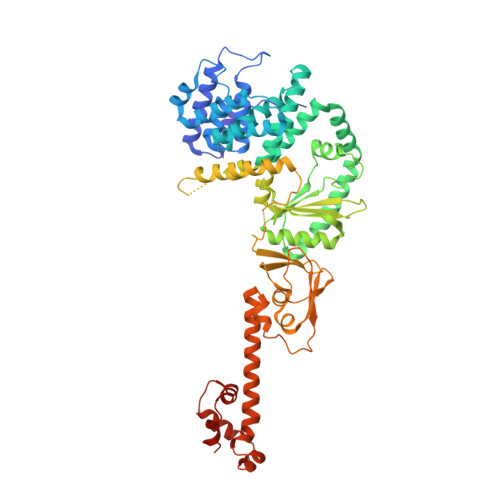Structural Basis for Regulation of the Opposing (p)ppGpp Synthetase and Hydrolase within the Stringent Response Orchestrator Rel.
Pausch, P., Abdelshahid, M., Steinchen, W., Schafer, H., Gratani, F.L., Freibert, S.A., Wolz, C., Turgay, K., Wilson, D.N., Bange, G.(2020) Cell Rep 32: 108157-108157
- PubMed: 32937119
- DOI: https://doi.org/10.1016/j.celrep.2020.108157
- Primary Citation of Related Structures:
6HTQ, 6YXA - PubMed Abstract:
The stringent response enables metabolic adaptation of bacteria under stress conditions and is governed by RelA/SpoT Homolog (RSH)-type enzymes. Long RSH-type enzymes encompass an N-terminal domain (NTD) harboring the second messenger nucleotide (p)ppGpp hydrolase and synthetase activity and a stress-perceiving and regulatory C-terminal domain (CTD). CTD-mediated binding of Rel to stalled ribosomes boosts (p)ppGpp synthesis. However, how the opposing activities of the NTD are controlled in the absence of stress was poorly understood. Here, we demonstrate on the RSH-type protein Rel that the critical regulative elements reside within the TGS (ThrRS, GTPase, and SpoT) subdomain of the CTD, which associates to and represses the synthetase to concomitantly allow for activation of the hydrolase. Furthermore, we show that Rel forms homodimers, which appear to control the interaction with deacylated-tRNA, but not the enzymatic activity of Rel. Collectively, our study provides a detailed molecular view into the mechanism of stringent response repression in the absence of stress.
Organizational Affiliation:
Center for Synthetic Microbiology & Department of Chemistry, Hans-Meerwein-Strasse, C07, Philipps-University Marburg, 35043 Marburg, Germany.















